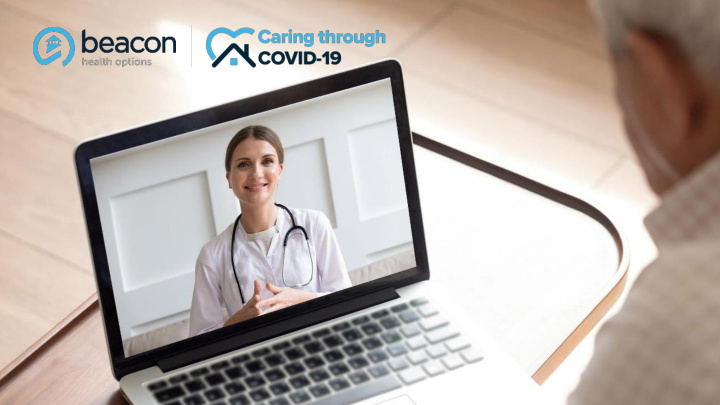



1
Best Practices and Implementation Procedures for Using Telehealth in PHP & IOP Anxiety Depression Job loss Working remotely 2
3
Agenda Learning Objective: Support our provider network with implementing telehealth for intensive outpatient programs (IOPs) and partial hospitalization programs (PHPs) as a result of COVID-19. • Overview of operationalizing a virtual group • Keeping patients engaged • Maintaining confidentiality • Crisis and risk in a virtual group setting • Toxicology screenings • Family involvement • “Lessons Learned” from providers currently conducting virtual IOP/PHP • Short discussion on the potential long term usage of virtual services • Question and Answer 4
Today’s speakers Jennifer Nelson Robert McAlonan, LCSW Interim Manager of Virtual Services Director of Provider Quality Paula Vass, LICSW, MBA, CEDS Stephen Delisi, MD Chief of Clinical Operations Medical Director, Professional Education 5
Overview of IOP and PHP Telehealth During COVID-19 Chapter • Beacon’s overall expectation is that providers continue to deliver the same level of service and clinical value using telehealth. • Virtual IOP and PHP must include audio and video technology. • IOP and PHP programming must include a written schedule or program activities, protocols for addressing risk, group notes and treatment planning. For virtual PHP, patients must be seen by a psychiatrist daily. • No more than 15 participants in a virtual IOP group and 10 for virtual PHP. • Virtual PHP: Ensure full-day programming (a minimum of 6 hours). Group therapy must take place at least four hours a day. 6
Chapter How has COVID-19 affected patient engagement? • There is a wide spectrum of patient willingness to participate in a virtual group. • Increased engagement when providers successfully adapt evidence-based programming to virtual delivery. • Clinical anecdote: Family more available and engaged in virtual eating disorder treatment during COVID-19. How do you ensure confidentiality in a virtual group? • Ensure virtual conferencing platforms are HIPPA compliant and 42 CFR Part 2 compliant, as applicable. • Patient handbook and informed consent for telehealth services should be specific. • Clinicians should “scan” the rooms and be aware of any breaches in privacy. What do I do if there is a crisis during or at the end of a virtual group session? • Emergency action plans specific to virtual programs. Have a plan! • Know the physical location of the patients and emergency contact information with Release of Information (ROI). • Agency should develop virtual crisis management policies, procedures and clinician training. 7
Chapter How do you continue toxicology screenings in a virtual program? • If available, patients can go to a physical lab location. • Oral swab and urine kits sent to home – DNA matching at the lab. How do you include family and collaterals in a virtual IOP or PHP? • Regular family and/or collateral virtual meetings. • Specific family/collateral support groups offered outside of the IOP/PHP programming. What have been some of your “lessons learned” in conducting virtual programs? • Telehealth increases access for people with financial, geographic, and/or transportation issues. • Virtual services provides a safer environment for those who struggle with close proximity to others. • Both clinicians and patients need orientation to virtual etiquette. • Establish “ground rules” specific to the virtual program . 8
Thinking ahead – How does COVID-19 affect the long- term utilization of a virtual framework? Chapter It is very possible that Beacon will be analyzing COVID-19 will have a how telehealth has lasting effect on the impacted access and ratio of outpatient behavioral health services offered via outcomes. telehealth. 9
Resources 10 10 10 10
Beacon COVID-19 Provider Resources Coronavirus Provider Resources (Link) Provider Webinars (Link) Additional Provider Webinars 1. Managing a Clinical Team Remotely 2. Compassion Fatigue for Providers/Clinicians 3. Triaging Referrals to Prioritize Access 4. Delivering Substance Use Disorder Care Via Telehealth Platform 11 11 11 11
Additional Resources Telehealth Resource Center Sydney Care Mobile APP – Go to app store to download PsychHub Aunt Bertha ACES AWARE Suicide Prevention Lifeline Crisis Text Line SAMHSA Disaster Distress Helpline 1-800-985-5990 The Daily Pledge Mobile MORE Field Guide to Life My Sober Life 12 12 12 12
Questions? Anxiety Depression Job loss Working remotely 13 13 13 13
Thank You This presentation will be posted at www.beaconhealthoptions.com/coronavirus/ CONTACT US: Beacon’s National Provider Services Line 800-397-1630 (Monday-Friday, 8 a.m.-8 p.m. ET) or contact your Provider Relations contact 14 14 14 14
Recommend
More recommend